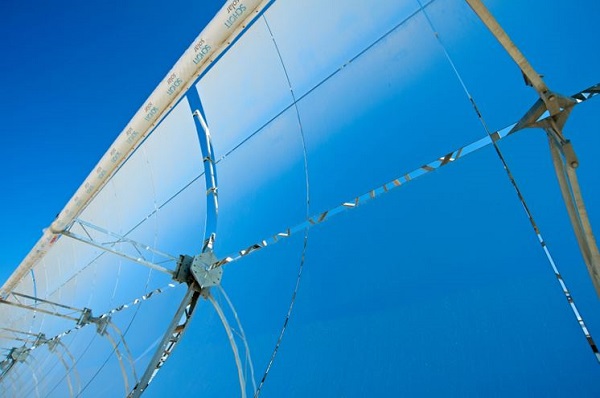A 100-megawatt parabolic trough solar project is up and operating in the United Arab Emirates, and the developers are calling it the world’s largest concentrating solar power plant. It is, too, if you don’t count a whole bunch of multi-unit power stations as single plants.
In any case, the “world’s largest” title is one that it won’t hold for long – the Ivanpah project in California’s Mojave Desert, expected to begin operations this summer, will be several times larger at 370 MW – but Shams 1 is still pretty impressive, especially coming in the oil-soaked Middle East.

The plant is majority owned by Abu Dhabi’s state-backed company Masdar, while the French firm Total and Spanish CSP specialist Abengoa both have 20 percent stakes. It took three years and cost $600 million to build the plant, the developer said.
Set in the Western Region in the emirate of Abu Dhabi — in “the center of the country’s hydrocarbon industry,” according to the developers — Shams 1 covers two and a half square kilometers with 768 long rows of parabolic collectors. These are curved, sun-tracking mirrors that focus sunlight on a fluid-filled receiver tube running directly above the mirrors. The heated fluid is then used to create steam to drive a generator.
This is one way to do concentrating solar power; another – as at Ivanpah – is with the power tower configuration, in which large, sun-tracking heliostats focus the energy on a receiver atop a tall tower.
This is an interesting time for CSP, with conflicting signs about its prospects. BrightSource, a major force behind the Ivanpah projet, withdrew an IPO bid last spring, then in October Siemens bailed on the sector. With PV becoming so cheap, a lot of talk about big CSP projects fading away arose.
Nevertheless, Ivanpah is scheduled to come online beginning in the middle of this year, and SolarReserve says the 110-MW Crescent Dunes power tower in Nevada will be operating before 2014 rolls around. Then there’s at least one big trough project that the developer says will begin operations in 2013 – the 280-MW Solana plant that Abengoa is building near Gila Bend, Ariz. (NextEra’s 250-MW Genesis trough project in Riverside County, Calif., is expected to be partially operating by the end of the year, as well.)
In addition, this past week BrightSource announced that it would partner with Abengoa to build the Palen project, two 250-MW power towers in California, beginning later this year and wrapping up, they hope, in 2016. That plant was approved for constructing using parabolic trough, but BrightSource decided late last year to switch to power tower, and is awaiting new sign-off from the California Energy Commission.
BrightSource says that power tower has the advantage of having lower impact. “The new design will reduce the project footprint by 13 percent, from 4,366 acres to approximately 3,800 acres, and use 50 percent less water by deploying a dry-cooling technology,” the company said.